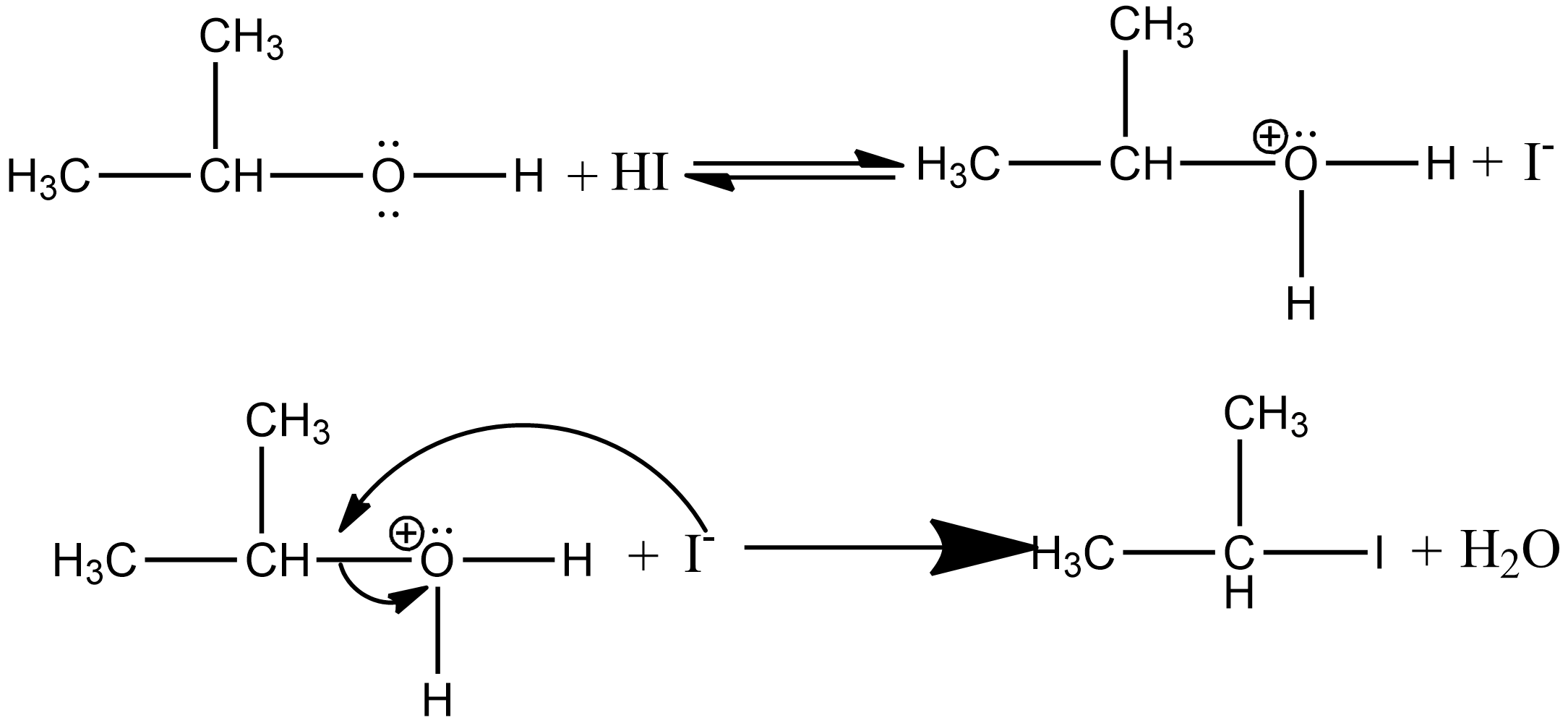
What are the products when ethyl isopropyl ether is cleaved with concentrated
A.Ethanol and 2-iodo-2- methylpropane
B.Ethanol and 2- methylpropane
C.Iodoethane and isopropyl alcohol
D.Iodoethane and 2-methylpropane
Answer
476.4k+ views
Hint: During the reaction of unsymmetrical ether having a different alkyl group with halogen acid, there is a formation of alcohol and alkyl halide and it also depends upon the nature of the alkyl group.
Complete step by step answer:
The reaction of ethyl isopropyl ether with concentrated

Here a secondary alkyl group is present hence the reaction occurs through the
Step 1: This step is the protonation step, since ether is a lewis base, undergoes protonation to form oxonium ions as:

Step 2: Since the iodide ion is a good nucleophile and due to steric hindrance of alkyl group iodide ion attacks the smaller alkyl group of the oxonium ion formed in step 1and displace the alcohol molecule by

Hence the correct answer is option C.
Additional information:
If there is an excess of concentrated

Note:
The reactivity of halogen acids towards the cleavage of ether follows the following order
Since the cleavage of ether by halogen acids involves the nucleophilic attack by the halide ion on the protonated ether molecule. Hence greater the nucleophilicity of the halide ion, the greater will be the reactivity of halogen acid. The order of nucleophilicity of halide ion is as given:
So we can say iodide ions are most reactive towards cleavage of ether as compared to bromide and chloride ions.
Complete step by step answer:
The reaction of ethyl isopropyl ether with concentrated

Here a secondary alkyl group is present hence the reaction occurs through the
Step 1: This step is the protonation step, since ether is a lewis base, undergoes protonation to form oxonium ions as:

Step 2: Since the iodide ion is a good nucleophile and due to steric hindrance of alkyl group iodide ion attacks the smaller alkyl group of the oxonium ion formed in step 1and displace the alcohol molecule by

Hence the correct answer is option C.
Additional information:
If there is an excess of concentrated

Note:
The reactivity of halogen acids towards the cleavage of ether follows the following order
Since the cleavage of ether by halogen acids involves the nucleophilic attack by the halide ion on the protonated ether molecule. Hence greater the nucleophilicity of the halide ion, the greater will be the reactivity of halogen acid. The order of nucleophilicity of halide ion is as given:
So we can say iodide ions are most reactive towards cleavage of ether as compared to bromide and chloride ions.
Latest Vedantu courses for you
Grade 11 Science PCM | CBSE | SCHOOL | English
CBSE (2025-26)
School Full course for CBSE students
₹41,848 per year
Recently Updated Pages
Master Class 4 Maths: Engaging Questions & Answers for Success

Master Class 4 English: Engaging Questions & Answers for Success

Master Class 4 Science: Engaging Questions & Answers for Success

Class 4 Question and Answer - Your Ultimate Solutions Guide

Master Class 11 Economics: Engaging Questions & Answers for Success

Master Class 11 Business Studies: Engaging Questions & Answers for Success

Trending doubts
Give 10 examples of unisexual and bisexual flowers

Draw a labelled sketch of the human eye class 12 physics CBSE

a Tabulate the differences in the characteristics of class 12 chemistry CBSE

Differentiate between homogeneous and heterogeneous class 12 chemistry CBSE

Why is the cell called the structural and functional class 12 biology CBSE

Differentiate between insitu conservation and exsitu class 12 biology CBSE




